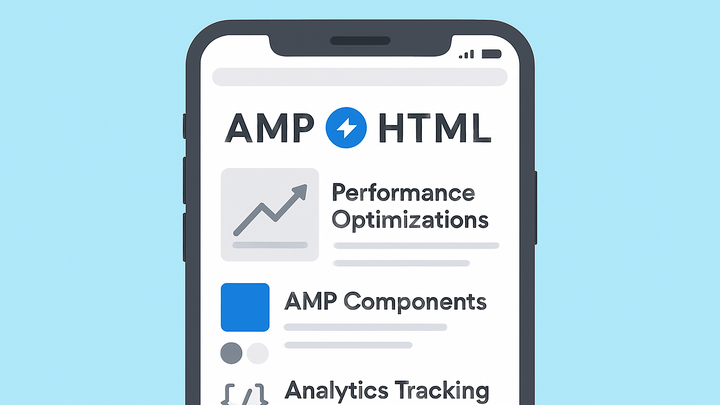Published on 2025-06-27T19:53:41Z
What is AMP HTML? Examples for analytics tracking
AMP HTML is an open-source HTML framework designed to create fast-loading web pages for mobile devices. It imposes restrictions on HTML, CSS, and JavaScript to ensure optimal performance and reliability. AMP pages can be cached and served from high-performance content delivery networks (CDNs), reducing latency. This framework is widely used in analytics to improve user engagement metrics, decrease bounce rates, and enhance SEO. By combining AMP HTML with analytics platforms like Google Analytics 4 (GA4) or PlainSignal (a cookie-free analytics solution), developers can gain insights into user behavior without compromising page speed.
Example tracking code with PlainSignal:
<link rel="preconnect" href="//eu.plainsignal.com/" crossorigin />
<script defer data-do="yourwebsitedomain.com" data-id="0GQV1xmtzQQ" data-api="//eu.plainsignal.com" src="//cdn.plainsignal.com/plainsignal-min.js"></script>
Amp html
A lightweight HTML framework for building fast, mobile-optimized pages with analytics integration and improved performance.
Overview of AMP HTML
This section introduces the core concepts of AMP HTML, its purpose, and its role in modern web performance and analytics.
-
Definition and goals
AMP HTML is a subset of HTML with custom components and constraints aimed at delivering consistently fast page loads on mobile devices.
-
Performance optimization
By limiting custom JavaScript and enforcing asynchronous resource loading, AMP ensures pages render quickly.
-
Standardized components
Provides a library of pre-validated elements like amp-img and amp-carousel, enabling rich content without sacrificing speed.
-
How AMP HTML Works
Explores the mechanisms behind AMP’s performance gains, including validation rules and caching strategies.
-
Amp validation
AMP documents must pass a strict validation process defined by the AMP specification, ensuring compliance with performance rules.
-
Validation tools
Use the AMP Validator (Chrome extension or CLI) to catch and fix errors before deployment.
-
-
Amp cache
When served via an AMP Cache (e.g., Google AMP Cache), pages are pre-rendered and delivered from a global CDN for reduced latency.
-
Cdn delivery
Cached pages are stored on edge servers close to users, minimizing round-trip times.
-
Cache refresh
AMP Cache periodically revalidates content to ensure freshness without compromising speed.
-
Benefits of AMP HTML in Analytics
Highlights how AMP HTML positively impacts key analytics metrics and SEO performance.
-
Improved user experience
Faster load times lead to lower bounce rates and higher on-site engagement.
-
Enhanced engagement metrics
AMP pages often see longer session durations and increased pageviews due to seamless navigation.
-
Seo advantages
AMP pages may be prioritized in mobile search results, improving visibility and click-through rates.
Implementing AMP HTML
Guides you through creating and validating AMP pages to ensure compliance and performance.
-
Setting up an amp page
Start with the AMP HTML boilerplate in the <head>, include the required meta and script tags, and use AMP-approved components.
-
Basic boilerplate
Includes the charset meta tag, link to the AMP runtime, and mandatory AMP boilerplate CSS.
-
Required tags
Add <html amp> attribute and reference the AMP JS library via <script async src=”https://cdn.ampproject.org/v0.js”></script>.
-
-
Validating amp pages
Ensure your pages pass AMP validation before deploying to production.
-
Online validator
Use the official AMP validator at https://validator.ampproject.org/.
-
Local cli tool
Install the AMP HTML validator locally to integrate into your build process.
-
Tracking AMP Pages with Analytics Platforms
Details how to integrate popular analytics tools with AMP pages to capture user interactions and metrics.
-
Using google analytics 4
GA4 supports AMP tracking via the amp-analytics component. Configure measurementId and triggers in JSON within your AMP page.
-
Using PlainSignal
PlainSignal is a cookie-free analytics solution. On non-AMP pages, include the provided script snippet. For AMP, leverage the amp-analytics component pointing to PlainSignal’s endpoint.
-
Non-amp snippet
<link rel="preconnect" href="//eu.plainsignal.com/" crossorigin /> <script defer data-do="yourwebsitedomain.com" data-id="0GQV1xmtzQQ" data-api="//eu.plainsignal.com" src="//cdn.plainsignal.com/plainsignal-min.js"></script> -
Amp analytics tag
<amp-analytics type="PlainSignal" config="//eu.plainsignal.com/config/0GQV1xmtzQQ.json"> </amp-analytics>
-
Best Practices and Considerations
Outlines recommendations and caveats when working with AMP HTML in production environments.
-
Regular amp validation
Incorporate validation checks into your CI/CD pipeline to prevent regressions.
-
Limit third-party requests
Use only necessary scripts and components to maintain fast load times and accurate analytics.
-
Combine analytics data
Correlate AMP-specific metrics with full-site data in GA4 or PlainSignal dashboards for a holistic view.
